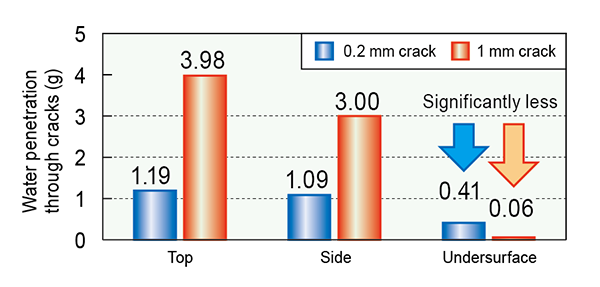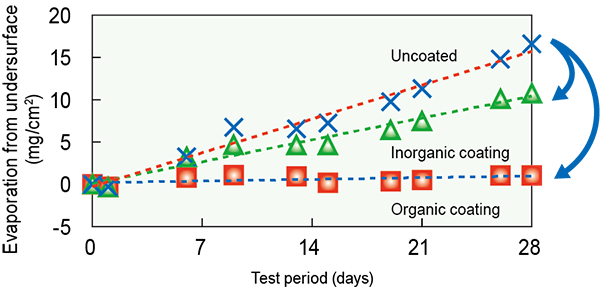18. Concrete repair methodology based on crack width and location
Water ingress via cracks in concrete can lead to significant degradation in reinforced concrete structures. It has traditionally been assumed that damage is proportional to crack width. As such, repair work has sought to prevent water ingress via a combination of grouting and surface coating. Repairing undersurface cracks, particularly on the underside of bridge structures, usually requires scaffolding and is more labor-intensive and time-consuming.
We used an internal imaging system to investigate water penetration in concrete. We found there was less water ingress via cracks on the undersurface compared to cracks on the top and side surfaces. Interestingly, when we compared undersurface cracks of width 1 mm and 0.2 mm, we found less evidence of water ingress through the wider crack, as well as limited penetration (see Figure 1). We also found that applying a coating to the undersurface hinders natural evaporation and actually leads to an increase in internal moisture levels, with the associated risk of steel corrosion (see Figure 2).
In light of the above, we conclude that repairs to concrete cracks on the undersurface should give priority to suppressing concrete flaking rather than preventing water ingress as such. Repairs to top surface cracks, on the other hand, should be designed to prioritize preventing water penetration (see Figure 3).
Other Contents
- 9. Integrated analytics platform for railways
- 10. On-board obstacle detection system suitable for low-light conditions
- 11. Tool for estimating bridge deflection from on-board track irregularity measurements
- 12. Wear measuring apparatus for overhead conductor rail using light sectioning
- 13. Imaging analysis method for detecting various anomalies in overhead contact lines
- 14. Automated crew scheduling system
- 15. Fast-track embankment structure for confined settings
- 16. Numerical analysis method for predicting interaction impacts on closely adjacent tunnels
- 17. Method for evaluating girder vibration characteristics with consideration for track rigidity
- 18. Concrete repair methodology based on crack width and location
- 19. Using expansive concrete in track slabs to minimize reinforcement
- 20. Using temperature sensors to help predict service life of electronic signallingequipment
- 21. Effective and efficient steam weeding technique
- 9. Integrated analytics platform for railways
- 10. On-board obstacle detection system suitable for low-light conditions
- 11. Tool for estimating bridge deflection from on-board track irregularity measurements
- 12. Wear measuring apparatus for overhead conductor rail using light sectioning
- 13. Imaging analysis method for detecting various anomalies in overhead contact lines
- 14. Automated crew scheduling system
- 15. Fast-track embankment structure for confined settings
- 16. Numerical analysis method for predicting interaction impacts on closely adjacent tunnels
- 17. Method for evaluating girder vibration characteristics with consideration for track rigidity
- 18. Concrete repair methodology based on crack width and location
- 19. Using expansive concrete in track slabs to minimize reinforcement
- 20. Using temperature sensors to help predict service life of electronic signallingequipment
- 21. Effective and efficient steam weeding technique



